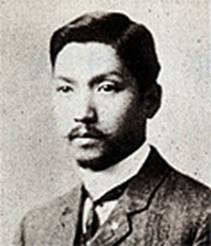Ōsugi Sakae
Appearance
You can help expand this article with text translated from the corresponding article in Japanese. (July 2022) Click [show] for important translation instructions.
|
Ōsugi Sakae | |
|---|---|
| 大杉 栄 | |
 Ōsugi c. 1920 | |
| Born | January 17, 1885 Marugame, Japan |
| Died | September 16, 1923 (aged 38) Tokyo, Japan |
Ōsugi Sakae (大杉 栄, January 17, 1885 – September 16, 1923) was a radical Japanese anarchist. He published numerous anarchist periodicals, helped translate western anarchist essays into Japanese for the first time, and created Japan's first Esperanto school in 1906. He, his lover, anarcha-feminist Itō Noe, and his nephew were murdered in what became known as the Amakasu incident.
In June 1920 Osugi was contacted by the Korean Yi Ch'un-Suk, who persuaded him to come to Shanghai and meet with Asian Communists involved with the Far Eastern Bureau of the Comintern.[1]
Director Kiju Yoshida made Eros + Massacre (エロス+虐殺) in 1969, about Ōsugi's life[2]
See also
References
- ^ Robert, Scalapino (1967). The Japanese Communist Movement 1920-19667. Berkeley: University of California Press.
- ^ Desser, David (1988). Eros Plus Massacre: An Introduction to the Japanese New Wave Cinema. Indiana University Press. pp. 73. ISBN 978-0-253-20469-1.
Bibliography
- Stanley, Thomas A (1982). Ōsugi Sakae, Anarchist in Taishō Japan: The Creativity of the Ego. Cambridge, Mass.: Council on East Asian Studies, Harvard University. ISBN 0-674-64493-X. OCLC 993334190.
Further reading
- Sakae Osugi (December 17, 1992). The Autobiography of Osugi Sakae. University of California Press.
- Filler, Stephen (2012). "The Theory and Practice of Early Literary Anarchism in Japan: Ōsugi Sakae, Arahata Kanson, and Miyajima Sukeo, 1911–1923". Studies in the Literary Imagination. 45 (2): 47–79. doi:10.1353/sli.2012.0010. ISSN 2165-2678. S2CID 159485477.
External links
- The Anarchist Movement in Japan, a pamphlet by John Crump; includes information on Ōsugi Sakae and Kōtoku Shūsui
- e-texts of Ōsugi Sakae at Aozora Bunko
- Ōsugi Sakae Archive at marxists.org
- Osugi and Bakunin compares Osugi's internationalism with Bakunin's Slavic chauvinism.
- The Legends of Ōsugi Sakae and Noe Ito
